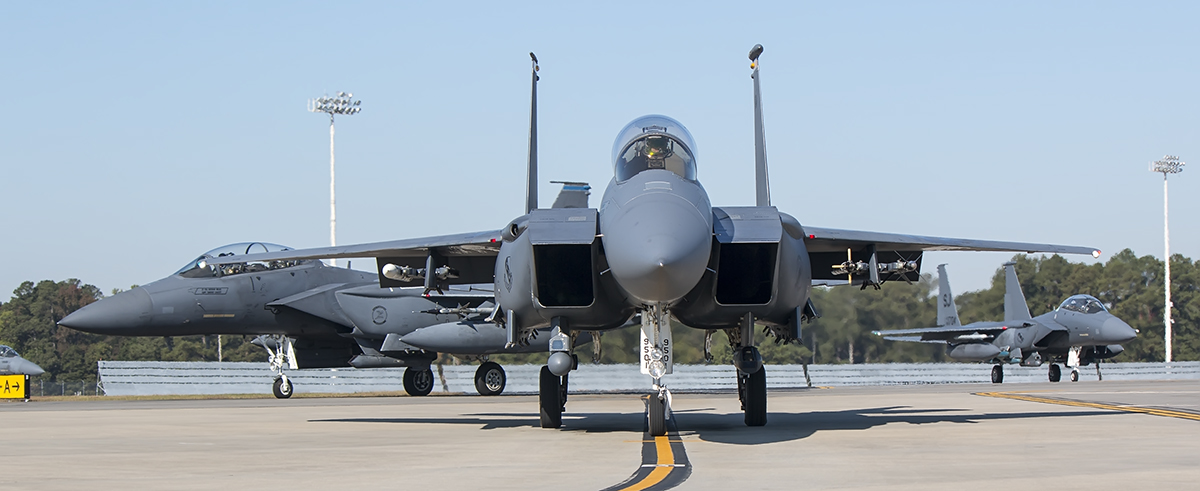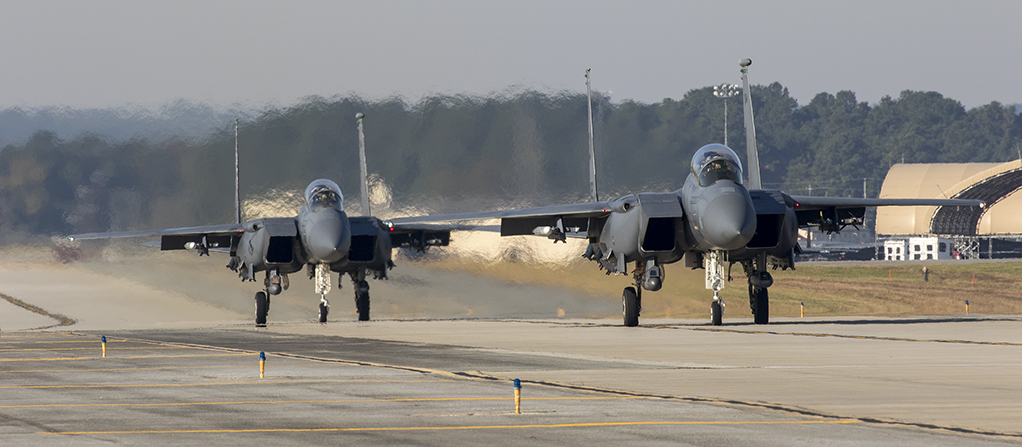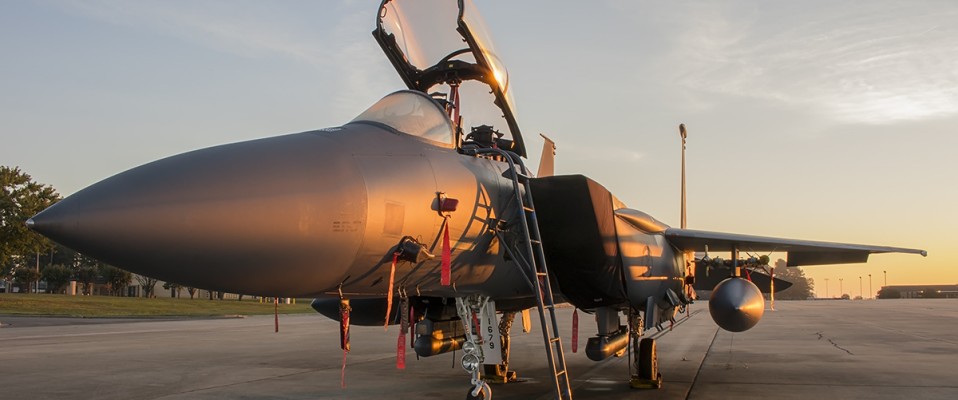Exercise Razor Talon: The Air Force Delivers Training Innovation
Todd Miller follows up on his widely-read coverage of Exercise Razor Talon with another visit to Seymour Johnson AFB to take a closer look at the exercise and its benefits. Here Todd takes an in-depth look at the people, operations and aircraft that make Exercise Razor Talon successful.
Article and Photos by Todd Miller
November 20, 2015
U
The battle is no place to be learning skills, but rather to practice learned skills.”The financial constraints are real the costly projects are critical yet there may be no greater need today than that of readiness. The Air Force must train with immediacy, as if they could be deployed to any corner of the globe to confront any situation at any time. Readiness of flight crews within the reality of an evolving “workforce” requires a logical, systematic approach to training; first on a platform and unit basis, then with interaction among dissimilar units, and finally by rotating units through large force exercises (LFE) such as Red Flag at Nellis AFB in Nevada. LFEs are a critical component for the proficiency and survivability of USAF aircrews – they simulate real warfare with an abundance of realistic threats and challenging mission sets.

Red Flag, the most intense and challenging LFE on the globe was borne as a response to the unacceptable “kill ratio” experienced by USAF pilots in the Vietnam war. The goal of the LFE such as Red Flag is to give aircrews their first 10 combat missions in a safe, learning environment. The survivability and success rates of crews with 10 combat missions jumps exponentially, and speaks decisively – the battle is no place to be learning skills, but rather to practice learned skills.
Warfare is more complicated than ever as a wide variety of specialized platforms are used in the battle and crews of each platform must understand the capabilities and roles of each to perform effectively as a team. LFE’s are critical to provide this interaction among dissimilar units, however, LFEs are costly. The LFE typically involves moving aircraft and support personnel en masse to a location such as Nevada, or Alaska (where they also hold a Red Flag), or any number of other theaters.
“Razor Talon” was born out of this reality, a monthly USAF driven LFE that began in 2011 as an innovative approach within the confines of fiscal restraint. The exercise has been so successful that it has become part of the training “fabric” on the East Coast of the US. The exercise is primarily rooted around the 4th FW Seymour Johnson (F-15E units flying strike), the 20th FW of Shaw AFB (F-16CM units flying SEAD), and the 1st FW of Langley AFB (F-22A units flying air dominance) with support from AWACS, ISR and Tanker units. The proximity of military bases in the mid-Atlantic frequently provides for participation by US Navy, Marine, Army, Coast Guard units, as well as overseas coalition units.

The coastal environment provided by the mid-Atlantic emulates future battles that will most likely include a coastal component. Coordination with Marine and Navy units (when they participate) to enact the Air-Sea Battle construct introduced a number of years ago is also a viable component.
On a high level Razor Talon scenarios may include defensive counter air (DCA), offensive counter air (OCA), but will most certainly include interdiction/strike, suppression of enemy air defense (SEAD), Intelligence, Surveillance, Reconnaissance (ISR), Air superiority/dominance, Close Air Support (CAS), dynamic targeting, refueling and more.
The nearby Dare County Range (46,000 acres) is available for dropping inert ordinance, and the Mid-Atlantic Electronic Warfare Range (MAEWR) provides a number of emitters that simulate surface to air missile (SAM) sites, enemy radars and ground platforms throughout the area. Upgrades to the range have been made over the years, and the growing training value justifies more extensive capabilities. In many cases targets are available on open water, where both static and high speed targets may be simulated. Beyond the ground targets, the coastal attackers must confront the aggressors of Red Air – typically a mix of T-38C’s, F-15Es and F-16s.
The primary cost savings is realized by integrating the wide variety of units into the exercise from their own home bases. Access to a complex LFE on a regular basis while flying from home base increases the pilot’s proficiency and prepares them for a more complex LFE (Red Flag) or in the event of a deployment ensures they have had exposure to “10 combat missions.”
Unlike most LFEs Razor Talon is built entirely on the model of distributed mission planning (DMP), an approach that coordinates all planning to local bases via secure network. Conflicts today utilize a wide variety of specialized resources from a variety of locations, yet most LFEs launch the bulk of participating units from the same base. The particular Razor Talon exercise held 10/23 was on the small side with just over 30 aircraft participating (vs. 50-60 aircraft that may be more typical) however the wide variety of participating bases was evident.
The initial briefing demonstrated the efficient and effective use of communicating remotely as part of distributed mission planning. Participating units joined the briefing from their home base via secure network. The briefing was led by Major Ronen “Snoop” Segal who covered the participating units, flight safety, ingress and egress routing, communication, range and flight parameters and then introduced specific personnel for discussion of weather and tanker support. The nature of the group participation was evident when one unit indicated that they would not be able to arrive on station until 30 minutes into the exercise. All groups were consulted real time and the entire exercise was subsequently pushed 30 minutes so the aircraft could be on station when the exercise commenced.
the flying is not an end to itself, it is the culmination of hours of preparation by scores of members.”
Following the general briefing Red Air was excused. Red Air moved to their own briefing, and Blue Air continued with discussion of the broad objectives and the interaction and tole of specific units. Unit specific briefing with aircraft tasking took place early the next morning. After briefing the 335th FS pilots and WSOs made their way to their lockers and geared up; G-suits, flight harnesses, and helmets were gathered and fitted. Similar scenes took place at each of the participating units locations within their own timing constraints (to arrive on station at their designated time). Once geared up, the flight crews returned to the desk for a final review of the weather, and then boarded the crew shuttles and moved to their assigned aircraft.
Aircraft crew chiefs had already been busy preparing the F-15E Strike Eagles of the 4th FW 335th FS “Chiefs”. Assisted by the crew chief(s), the pilot and WSO performed their own walk around, and then settled into the aircraft. Open panels were snapped closed and double checked. After a few moments, the growl of the F-15Es powerful engines began and quickly transitioned to a high pitched whine as the engines settled into idle.
Strike Eagles at the EOR receiving final checks prior to mission launch
Video by Todd Miller
With canopies down and initial checks complete the Strike Eagles left their shelters and taxied to the end of runway (EOR). The EOR was particularly busy with Razor Talon aircraft interacting with a number of F-15Es from other squadrons (336th & 334th FS) that were on “regular” unit training missions. The aircraft paused at the EOR while ground crew performed visual checks and pulled ordinance pins. When checks were completed the strikers were cleared to the runway for launch.
Over the next 2 – 2.5 hours the aircraft moved to their starting points for their assigned missions and executed. The entire exercise was supervised by a group of personnel referred to as “White Force.” White Force call missile shots, and work together with those at the MAEWR to determine SAM kills, etc.. Once missions were completed and the flight crews returned to base they participated in a 2.5 to 3 hour debriefing that objectively critiqued what was done well, and where improvement could be made. From start to finish it was treated as if it were a real mission in a real warfare scenario.
Observing the personnel involved from start to finish it is clear that the flying is not an end to itself, it is the culmination of hours of preparation by scores of specialize personnel. In this respect Razor Talon offers tremendous value for virtually all Air Force disciplines.
It is anticipated that Razor Talon will continue and will grow. This kind of internally initiated program harnesses the latest technology and combines it with a common sense approach that actually reduces costs while increasing proficiency! It is a laudable that local leadership identified the need – and created Razor Talon. It has often been said that pressure has the potential to break people or organizations, or bring out the best in them. Razor Talon is a clear example of the latter; it is a best case scenario in so many respects. Reduced cost, increased proficiency…under pressure. The flight crews of the USAF confront real and immediate danger around the globe. It is impressive and reassuring to see the quality of training undertaken and the professional conduct of the entire group of men and women we know as the USAF.





